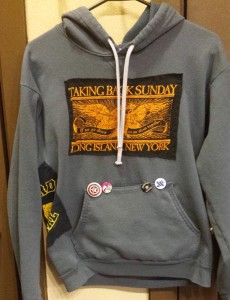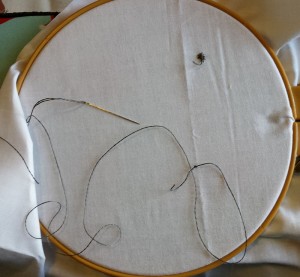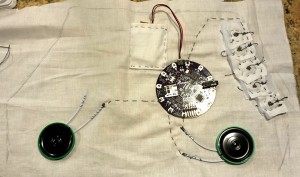
The original idea behind the Theme Music Hoodie was to be able to have a quick way to a.) share your favorite music with others and b.) carry your own soundtrack with you wherever you go. The hoodie has an LilyPad MP3 and two speakers sewn into a piece on lining on the inside of the front pocket. Five buttons are located on the left side of the pockets, and each button triggers a different piece of music loaded from a micro SD card.
Music is closely tied with one’s identity, emotions, and culture. It can play a significant role in not only shaping who we are, but also how (we want) others to see us. Many romantic couples have a song they call their own, and most people have a favorite artist or band, even if it changes frequently. People wait in long lines for the doors to happen before a concert. People scream and cry during performances. Religious music has long been a mainstay, with many of the West’s greatest composers wrote songs of worship. Break-up songs and movie soundtracks have a unique ability to draw out the emotions of an audience.
What you wear signifies something to those around you. While Elizabeth Wilson was expressly writing about dreadlocks in “Oppositional Dress”, the sentiment remains the same for any style – it “is an open and deliberate sign of affiliation and both friends and foes recognize it as such” (Wilson, 255). One’s style categorizes him into a specific cultural group of like-minded individuals (Barnard, 20). In this way, fashion goes hand-in-hand with music. Many people connected to a particular music scene already “wear” their music on their sleeves in the form of band/music shirts and clothing, pins, buttons, accessories, and patches. The Theme Music Hoodie follows this kind of DIY aesthetic, complete with a few patches ripped from old t-shirts and some pins I had lying around and the added bonus of pushing the music/fashion idea a little further.
Construction
Supplies
- LilyPad MP3
- Small speakers
- Headphones
- Micro SD card and adapter
- Conductive thread
- Regular sewing thread
- Sewing needles
- Seam ripper
- Batting
- Small embroidery hoop
- Polymer lithium ion battery – 850mAh
- Alligator cables
- 5V FTDI breakout and mini USB cable
- Hoodie, slightly used
- Extra fabric
- lining fabric
- Soldering iron
- Adobe Audition
I started by laying out all the components on top of the hoodie for placement purposes. My original hoodie candidate was NOT going to work. Luckily, I had an back-up to use. From there I cut out a piece of interfacing to use as the base for my work. With everything laid out, I set out to create the soft circuits. This turned out to be a huge challenge for me. Having never made soft circuits before, I googled a couple of tutorials, and made a test out of felt, scraps, interfacing and conductive thread. Though the test button I made worked, the 5 others failed miserably and made my hands cramp. The felt wasn’t enough to keep the circuit open until I needed it closed, and I cut my finger when cutting out the felt. Clearly, this direction was too dangerous for me.

so I set about making a new type of button. This one had large knots of conductive thread on each side with batting in the middle. The batting kept the circuit open until pressed. Round 2 involved buying some lining material and an embroidery hoop. I sewed ten large knots in the lining material, cut them all out, and attached 5 of them to a pocket cutout of lining material. After that, I put down a layer of batting and carefully sewed the other 5 knots onto the top, making sure that a “tail” of conductive thread from each knot stuck out. Then I ripped out the seams to the front pocket of the hoodie to reattach the lining with the components to later.

On the lining cutout, I created a pocket to hold the battery, sewed down the LilyPad MP3, and glued the speakers into place. From there, I sewed down all the paths to the circuits. After a quick test, a lead to one of the speakers broke and had to be soldered back on.
Once everything was attached to the lining, I sewed it onto the front pocket in such a way that you could still put your hands in the pocket without disrupting any of the components. I also left the top portion fastened with button pins so I could still easily reach the power switch and micro SD card. One last test had me ripping all the seams again so I could re-solder another speaker lead.
With everything put together, all I had left to do was to load some songs onto the micro SD card and mount it back into the Lilypad MP3.
Here’s the completed test:
References:
- Wilson, Elizabeth. Excerpt from “Oppositional Dress” in Fashion Theory: A Reader 253 – 255 (3 pps)
- Barnard, Malcolm. “Etymologies and Definitions of Fashion and Clothing” in Fashion as Communication 8 – 26 (17 pps)

Leave a Reply
You must be logged in to post a comment.